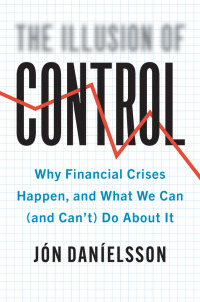Answered step by step
Verified Expert Solution
Question
1 Approved Answer
q 2 Problems with the IRR method Acme Oscillators is considering an investment project that has the following rather unusual cash flow pattern: a. Calculate
q 2 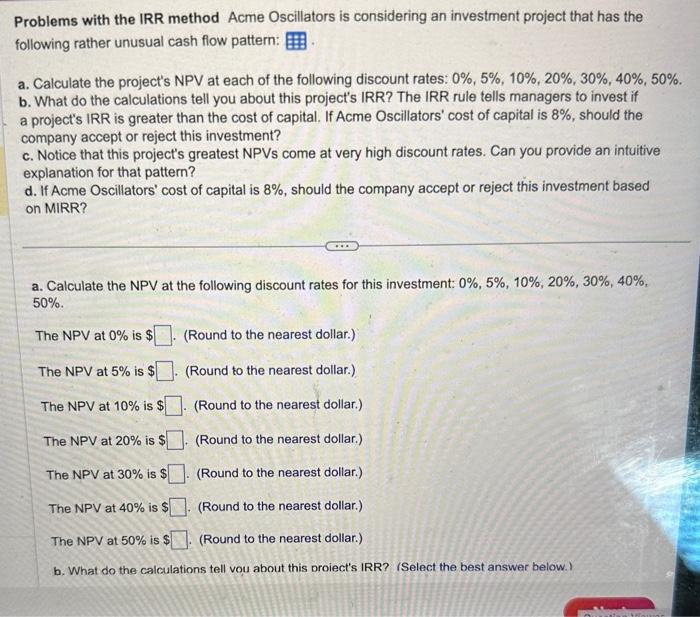
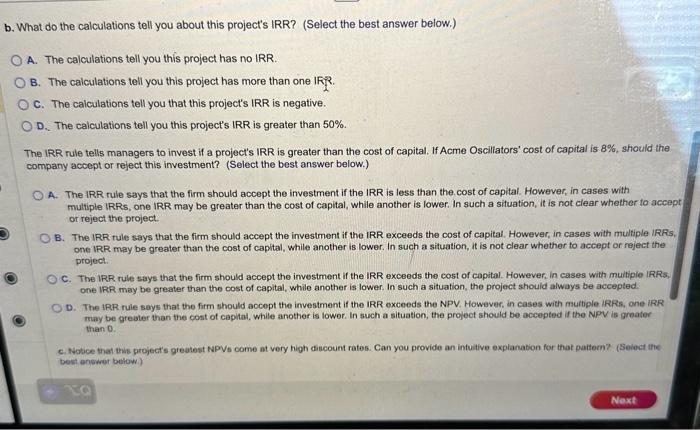
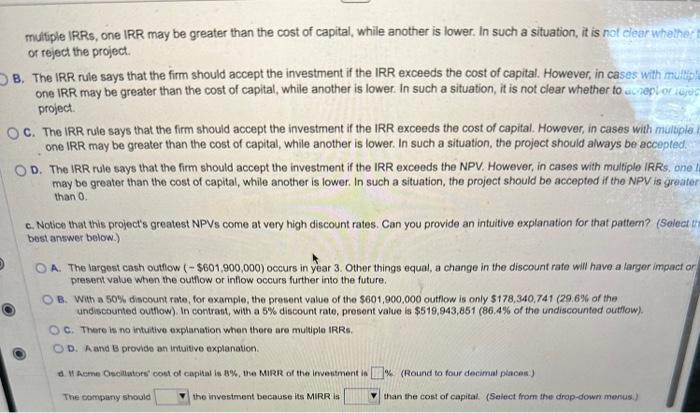
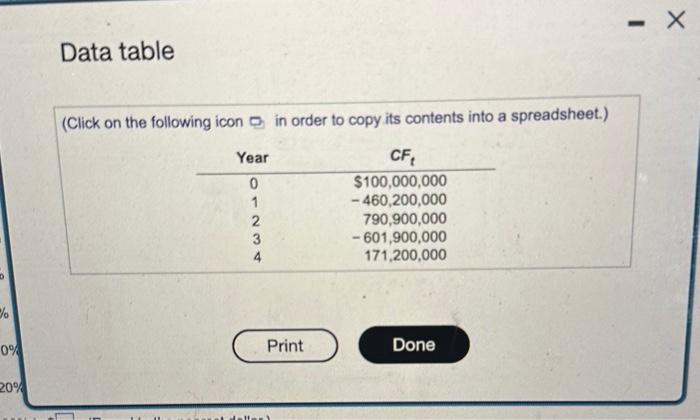
Problems with the IRR method Acme Oscillators is considering an investment project that has the following rather unusual cash flow pattern: a. Calculate the project's NPV at each of the following discount rates: 0%,5%,10%,20%,30%,40%,50%. b. What do the calculations tell you about this project's IRR? The IRR rule tells managers to invest if a project's IRR is greater than the cost of capital. If Acme Oscillators' cost of capital is 8%, should the company accept or reject this investment? c. Notice that this project's greatest NPVs come at very high discount rates. Can you provide an intuitive explanation for that pattern? d. If Acme Oscillators' cost of capital is 8%, should the company accept or reject this investment based on MIRR? a. Calculate the NPV at the following discount rates for this investment: 0%,5%,10%,20%,30%,40%, 50%. The NPV at 0% is $. (Round to the nearest dollar.) The NPV at 5% is $. (Round to the nearest dollar.) The NPV at 10% is $. (Round to the nearest dollar.) The NPV at 20% is $. (Round to the nearest dollar.) The NPV at 30% is $. (Round to the nearest dollar.) The NPV at 40% is $. (Round to the nearest dollar.) The NPV at 50% is $ (Round to the nearest dollar.) b. What do the calculations tell vou about this proiect's IRR? (Select the best answer below.) W. What do the calculations tell you about this project's IRR? (Select the best answer below.) A. The calculations tell you this project has no IRR. B. The calculations tell you this project has more than one IFP. C. The calculations tell you that this project's IRR is negative. D. The calculations tell you this project's IRR is greater than 50%. The IRR rule tells managers to invest if a project's IRR is greater than the cost of capital. If Acme Oscillators' cost of capital is 8%, should the company accept or reject this investment? (Select the best answer below.) A. The IRR rule says that the firm should accept the investment if the IRR is less than the cost of capital. However, in cases with multiple IRRs, one IRR may be greater than the cost of capital, while another is lower. In such a situation, it is not clear whether to accept or reject the project. B. The IRR rule says that the firm should accept the investment if the IRR exceeds the cost of capital. However, in cases with multiple IRRis, one IRR may be greater than the cost of capital, while another is lower. In such a situation, it is not clear whether to accept or reject the project C. The IRR. rule says that the firm should accept the investment if the IRR exceeds the cost of capital. However. in cases with multipie IRRs. one IRR may be greater than the cost of capital, while another is lower. In such a situation, the project should always be accepted. D. The IRR ruie says that the firm should accept the investment if the IRR exceeds the NPV. However, in cases with muitiple IRRs, one IRR may be gresier than the cost of cepital, while another is lower. In such a situation, the project should be accepted if the NPV is, greater than 0. c. Notice that this project's greatost NPVs come at very high discount rates. Can you provide an intuitive explanabion for that paitem? (Seioct ine best answer betow.) multiple IRRs, one IRR may be greater than the cost of capital, while another is lower. In such a situation, it is not clear whelhe of reject the project. B. The IRR rule says that the firm should accept the investment if the IRR exceeds the cost of capital. However, in cases with multip? one IRR may be greater than the cost of capital, while another is lower. In such a situation, it is not clear whether to project. C. The IRR rule says that the firm should accept the investment if the IRR exceeds the cost of capital. However, in cases with mulbipla one IRR may be greater than the cost of capital, while another is lower. In such a situation, the project should always be accepted. D. The IRR rule says that the firm should accept the investment if the IRR exceeds the NPV. However, in cases with multiplo IRRs, one may be greater than the cost of capital, while another is lower. In such a situation, the project should be accepted if the NPV is greater than 0. c. Notice that this project's greatest NPVs come at very high discount rates. Can you provide an intuitive explanation for that pattem? (Salect best answer below.) A. The largest cash outfow ($601,900,000) occurs in year 3 . Other things equal, a change in the discount rate will have a larger impact or present value when the outllow or intlow occurs further into the future. B. With a 50% discount rate, for example, the present value of the $601,900,000 outflow is only $178,340,741(29,6% of the undiscounted outhow). In contratt, with a 5% discount rate, present value is $519,943,851 (86.4\% of the undiscounted outflow). c. There is no intuitive explanation when there are multiple IRRs. D. A and B provioe an intuitive explanation. A. 11 Aeme Oscillators cost of capital is B\%, the MiRR of the inveitment in W. (Round to four decimal piacen.) The company should the investment because its MIRR is than the cost of capitat. (Solect from the drop-down menus.) Data table (Click on the following icon in order to copy its contents into a spreadsheet.) 



Step by Step Solution
There are 3 Steps involved in it
Step: 1

Get Instant Access to Expert-Tailored Solutions
See step-by-step solutions with expert insights and AI powered tools for academic success
Step: 2

Step: 3

Ace Your Homework with AI
Get the answers you need in no time with our AI-driven, step-by-step assistance
Get Started


